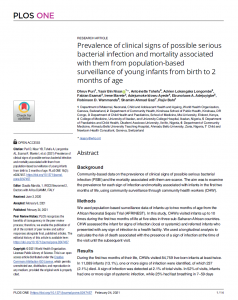
Background
Community-based data on the prevalence of clinical signs of possible serious bacterial infection (PSBI) and the mortality associated with them are scarce. The aim was to examine the prevalence for each sign of infection and mortality associated with infants in the first two months of life, using community surveillance through community health workers (CHW).
Methods
We used population-based surveillance data of infants up to two months of age from the African Neonatal Sepsis Trial (AFRINEST). In this study, CHWs visited infants up to 10 times during the first two months of life at five sites in three sub-Saharan African countries. CHW assessed the infant for signs of infection (local or systemic) and referred infants who presented with any sign of infection to a health facility. We used a longitudinal analysis to calculate the risk of death associated with the presence of a sign of infection at the time of the visit until the subsequent visit.
Results
During the first two months of their life, CHWs visited 84,759 live-born infants at least twice. In 11,089 infants (13.1%), one or more signs of infection were identified, of which 237 (2.1%) died. A sign of infection was detected at 2.1% of total visits. In 52% of visits, infants had one or more sign of systemic infection, while 25% had fast breathing in 7–59 days period and 23% had a local infection. All signs of infection, including multiple signs, were more frequently seen in the first week of life. The risk of mortality was very low (0.2%) for local infections and fast breathing in 7–59 days old, it was low for fast breathing 0–6 days old (0.6%), high body temperature (0.7%) and severe chest indrawing (1.0%), moderate for low body temperature (4.9%) and stopped feeding well/not able to feed at all (5.0%) and high for movement only when stimulated or no movement at all (10%) and multiple signs of systemic infection (15.5%). The risk of death associated with most clinical signs was higher (1.5 to 9 times) in the first week of life than at later age, except for low body temperature (4 times lower) as well as high body temperature (2 times lower).